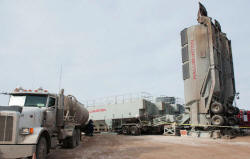|
Pullback in U.S. fracking
sand use pressures producers
 Send a link to a friend
Send a link to a friend
 [August 16, 2017]
By Arathy S Nair and Nivedita Bhattacharjee [August 16, 2017]
By Arathy S Nair and Nivedita Bhattacharjee
(Reuters) - U.S. shale oil companies are
pulling back on the amount of sand they use to hydraulically fracture
new wells, responding to rising prices of the material that are driving
up costs.
Investors worry a slowdown in sand use, combined with new mining
capacity coming online, could lead to a glut of the material and bring
down prices. The worries have pressured shares of sand companies.
Sand prices soared in the last year as oil companies ramped up shale
drilling and production.
But with crude <LCoC1><CLC1> prices below where they started the year,
oil producers are employing new well designs and chemical agents that
lessen the use of sand that represents around 12 percent of the cost of
drilling and fracturing.
The price of frack sand is expected to rise 62 percent this year to
average $47 a ton, according to researcher IHS Markit. That is expected
to drive oilfield service price inflation to 15 percent over 2016,
according to researchers at Wood Mackenzie.
Oilfield services provider Halliburton Co <HAL.N>, which buys sand for
its drilling customers, last month reported its first decline in average
sand used per well, saying customers wanted designs that consumed less
of the material.

Average sand volumes for each foot of a well drilled fell slightly last
quarter for the first time in a year, said exploration and production
consultancy Rystad Energy. Volumes are expected to drop a further 2.5
percent per foot in the current quarter over last, Rystad forecast.
"As alternative strategies are optimized, sand density will fall on a
foot by foot basis – dramatically in time," said Dallas Salazar, chief
executive of energy consulting firm Atlas Consulting.
For a graphic showing frack sand use per well over time, see: http://tmsnrt.rs/2fHzJbc
LOGISTICS PROBLEMS?
Frack sand is mixed in a slurry and forced at high pressure into wells
to free oil and gas trapped in rocks. Any weakening of sand demand would
collide with several sand producers' plans to open new mines.
Companies including Unimin Corp, U.S. Silica Holdings Inc <SLCA.N>, and
Hi Crush Partners LP <HCLP.N> are spending hundreds of millions of
dollars on new mines to address an expected increase in demand.
[to top of second column] |

Halliburton SandCastle PS-2500 trailers, which store sand for
hydraulic fracturing, also known as fracking, stand at a Hess well
site near Williston, North Dakota November 12, 2014. REUTERS/Andrew
Cullen (/File Photo

On Thursday, supplier Smart Sand <SND.O> reported it shipped less frack sand in
the second quarter than it did in the first. Rival Fairmount Santrol Holdings
Inc <FMSA.N> forecast flat to slightly higher volumes this quarter over last.
In the last six weeks, shares of U.S. Silica and Hi Crush are both off about 30
percent. Smart Sand is off about 43 percent since June 30.
Some shale producers add chemical diverters, compounds that spread the slurry
evenly in a well, and can reduce the amount of sand required. Anadarko Petroleum
Corp <APC.N> and Continental Resources Inc <CLR.N> are reducing the distance
between fractures to boost oil production. The tighter spacing allows them to
extract more crude with less sand.
In the Denver-Julesburg Basin of Colorado, Anadarko said the new well designs
have increased oil and gas production by as much as 35 percent. It is "no secret
we have experimented with less sand out there," Bradley Holly, Anadarko's head
of U.S. onshore exploration and production, told analysts last month.
Analysts and frack sand providers continue to forecast an overall rise in sand
consumption as more wells are drilled and completed. Smart Sand last week blamed
its decline on operational and logistics problems.
"The cases where people were scaling back [sand] usage, that was probably due to
logistics problems," Duane Scardino, Hi Crush's corporate development manager,
said in an interview this week. "It's hard for me to imagine what would be more
cost effective than frack sand."
Still, Atlas Consulting's Salazar said of the major U.S. shale basins, only two
- Haynesville and Eagle Ford - are pumping in more sand per well.

(Reporting by Arathy S Nair and Nivedita Bhattacharjee in Bengaluru; Editing by
Gary McWilliams)
[© 2017 Thomson Reuters. All rights
reserved.] Copyright 2017 Reuters. All rights reserved. This material may not be published,
broadcast, rewritten or redistributed. |